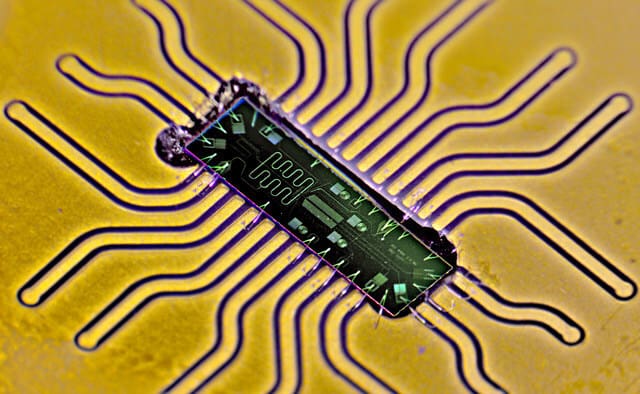Quantum computing has long been hampered by the need for ultra‑cold environments. Cooling a chip to millikelvin temperatures is costly and limits the number of qubits that can be packed into a single refrigerator. In a surprising turn, the Chicago‑based startup EeroQ has published a paper in Physical Review X showing that it can trap and manipulate individual electrons on the surface of superfluid helium at temperatures above one kelvin , more than a hundred times warmer than previous experiments. The breakthrough suggests that quantum processors could operate with far less stringent cooling, easing engineering constraints and bringing the technology closer to practical deployment.
Technical Breakthrough
EeroQ’s approach relies on a delicate platform called electron‑on‑helium. A thin film of superfluid helium is deposited on a silicon substrate, and a single electron is held above the surface by a carefully engineered electrostatic trap. Because helium is an almost perfect insulator, the electron experiences negligible environmental noise, which preserves its quantum state for long periods. However, the electron’s motion is highly sensitive to temperature; past research required temperatures below 10 milli‑kelvin to keep the system coherent.
The new study demonstrates that by refining the trap geometry and employing a novel surface‑passivation technique, the team can keep the electron coherent at temperatures just above one kelvin. The key lies in reducing the interaction between the electron and residual helium vapor molecules. The researchers coated the helium surface with a monolayer of inert gas, which suppresses scattering events that would otherwise decohere the qubit. Additionally, they introduced a dynamic feedback loop that stabilises the trap potential in real time, compensating for thermal fluctuations that would normally disturb the electron’s position.
At 1.2 kelvin, the electron’s coherence time , the interval over which it can retain a superposition , exceeds 10 microseconds, a figure that rivals or surpasses that of leading superconducting qubits operating at 20 milli‑kelvin. Importantly, the experiments were carried out in a standard dilution refrigerator that already supports many other quantum devices, indicating that the electron‑on‑helium platform can be integrated into existing infrastructure without major redesign.
Industry Implications
The ability to operate at higher temperatures could transform the economics of quantum hardware. Current superconducting qubit systems require large, custom cryogenic plants that consume significant power and occupy substantial floor space. By contrast, a helium‑based system that functions at 1 kelvin could use smaller, more efficient cryocoolers, reducing both capital and operating costs. This shift would lower the barrier to entry for mid‑sized companies and academic labs that cannot afford the expensive refrigeration suites demanded by millikelvin‑scale devices.
Moreover, the electron‑on‑helium architecture offers a path to higher qubit densities. Because the electrons are confined to a two‑dimensional plane, they can be packed more tightly than three‑dimensional superconducting circuits. EeroQ’s prototype chip already contains a grid of 16 trapping sites, and the team plans to scale up to hundreds of sites in future iterations. The modularity of the design means that individual trapping arrays could be fabricated on separate wafers and then tiled together, simplifying manufacturing and maintenance.
The technology also dovetails with emerging quantum networking efforts. Electrons on helium can couple naturally to microwave photons, a common medium for transmitting quantum information over short distances. The higher operating temperature could enable more robust inter‑chip communication, potentially easing the integration of quantum processors with classical control electronics that operate at room temperature.
Future Outlook
While the 1‑kelvin benchmark is a major milestone, several challenges remain before electron‑on‑helium qubits can compete with established platforms. Scaling the system to thousands of qubits will require precise control over each trapping site and reliable error‑correction schemes tailored to the unique noise profile of the helium surface. Additionally, the helium film must be maintained with exceptional purity; any contamination can introduce decoherence pathways that degrade performance.
EeroQ is already collaborating with university research groups to explore surface‑engineering techniques that could further raise the operating temperature. If successful, operating at 4 kelvin , the temperature of the cheapest commercial cryocoolers , would eliminate the need for dilution refrigerators altogether. Such a development would make quantum processors compatible with standard data‑centre infrastructure, accelerating adoption in fields ranging from cryptography to material science.
Beyond the laboratory, the broader quantum industry is watching closely. Major cloud‑quantum providers are investing in diverse hardware platforms, and the prospect of a more affordable, scalable qubit technology could reshape the competitive landscape. If EeroQ’s approach proves commercially viable, it may spur a wave of new entrants focused on helium‑based qubits, diversifying the ecosystem and fostering innovation in error‑correction, interconnects, and application software.
In sum, controlling single electrons on helium at temperatures above one kelvin marks a significant stride toward practical quantum computing. By breaking free from the millikelvin constraint, EeroQ has opened a new avenue for cost‑effective, high‑density quantum processors. Whether this path will become the dominant route to large‑scale quantum advantage remains to be seen, but the breakthrough certainly widens the horizon for what quantum technology might eventually achieve.

